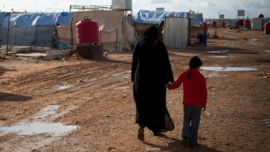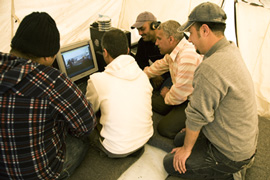
Leaving al-Tanf
After years of living in the grim conditions of a desert camp, Palestinian refugees move on.
When hundreds of Palestinians from Iraq arrived at the al-Tanf crossing on the Syrian border in May 2006, no country in the region would accept them.
Returning to Iraq was not an option, so UNHCR set up a tent camp in the border no-man’s land. Relocation to the West was slow, and as the months turned into years many of the camps inhabitants found it hard to maintain hope.
Finally in late 2009 it was announced that al-Tanf was to close permanently.
Filmmaker Edith Champagne was in the camp as one of the last groups prepared themselves to leave for Italy.
The road from Damascus to the border of Syria and Iraq gradually reveals a lonely and barren landscape.
But just past the Syrian border station, tucked in between a 20-foot high concrete wall and a highway where trucks alternately speed by or sit idle for hours at a time waiting to make the border crossing, was the al-Tanf refugee camp.
This narrow strip of no-man’s land between Syria and Iraq was home to some 1,300 Palestinian Iraqis over the course of three years. When we arrived for the filming, I found it hard to imagine that anyone could live here.
 |
| Children play football while trucks pass only a few meters away from them [UNHCR/B.Diab] |
Right away we could tell that the living conditions were difficult, even dangerous.
The isolation had to be depressing, but at the same time something felt different.
Al-Tanf was first established in May 2006, when hundreds of Palestinians fleeing persecution in Iraq tried to cross into Syrian territory.
Palestinians, like many Iraqis, were subjected to kidnappings, arbitrary detention, mass killings, and extreme violence after the US invasion.
Though neighbouring countries opened their borders to hundreds of thousands of Iraqi refugees, Palestinian refugees fleeing Iraq were barred from entering.
With no country in the region willing to take them in, the refugees remained stranded in the desert, and were rendered completely reliant on aid agencies for their survival.
The UNHCR set up the tent city in the desert, thinking it would be open for a few weeks.
More than three years later the camp is finally closing, but there are still hundreds of refugees from Iraq in the camp, unsure of where they would be going.
As soon as we arrived, the children insisted on performing a traditional dance for us.
Then we were given a tour of the so-called computer classroom, the art class and the women’s committee room. There was a sense of pride in the air.
This camp was like a small village, and the community spirit born here was directed to fighting for the cause of the refugees trapped at the border.
Determined to overcome misfortune
 |
| The camp is located in a narrow strip between the Syrian and Iraqi borders [UNHCR/B.Diab] |
Leaving the life you know under threat of death, never to return home, is traumatic.
Living in a tent in the desert for three years only adds to that trauma, but these refugees made it clear that they were determined to overcome their misfortune.
My producer, Farah Dakhlallah, and I met an older man, who asked us in perfect English if we wanted a cup of coffee.
He explained that he had been an engineer in Baghdad. Now he was moving to Sweden and hoped to start working again.
At the other end of the camp, a grandmother told us that she too was moving to Sweden and that in five years she could be a Swedish citizen.
She said that would allow her to visit Palestine, which she hadn’t seen since she was five years old. The place was full of dreams.
And then there was Ali. As we started filming, Ali seemed to be everywhere all the time. He was in the computer class, he taught chemistry, oversaw the dance practice… he kept getting into all the shots.
We were not quite sure what to make of him until we realised how much he cared about the plight of the refugees.
Ali had been in al-Tanf for two years. Finally, he and his family were going to Italy. In Baghdad, Ali worked as a journalist, but at the camp, he was a camp organiser, a teacher – and a refugee.
Targeted for being Palestinian, Ali and his family fled Baghdad after his brother disappeared. His editor-in-chief was murdered, Ali himself was kidnapped twice, evicted from his home and several times displaced before he and his wife made the decision to flee to Syria.
Ali came to Syria illegally joining thousands of other Palestinians from Iraq living clandestine lives in Damascus.
“We were afraid to show our ID, so we told our children not to speak Palestinian but to speak Iraqi,” Ali said.
He eventually turned himself in and he and his family were sent to al-Tanf.
Al-Tanf media group
 |
| The al-Tanf media group produces films about life in the camp [UNHCR/B.Auger] |
The living conditions in the camp were unbearable and frustrating.
But Ali found a way to draw much needed attention to the plight of the refugees in al-Tanf.
“The boys used to be bored most of the time. I had a small digital camera and a computer so I went back to my old work, becoming an amateur videographer.
“I would film in the camp and organise screenings, then I said to the boys: Why don’t we put these all together in a film?”
The al-Tanf Media group produced films to prove desperate camp conditions.
They captured happy moments, but also disasters, fires that reduced tents to cinders in minutes, floods that destroyed what little the refugees had, snow and sandstorms.
We found his idea of making videos of life in the camp, with cell phones and small cameras, inspiring.
Ali was doing what filmmakers rarely have a chance to do: follow a story not just for a few hours, days or months, but for years.
He managed to harness what little modern technology had to offer him in this camp that he called home.
And the films, documenting the daily struggles of the desert camp and life as it was, helped international organisations advocate for the refugees trapped at the border.
Leaving al-Tanf
 |
| Around 300 refugees from al-Tanf were transferred to al-Hol camp [UNHCR/B.Diab] |
The campaign and the consistence of the agencies worked.
In 2008, the first group of refugees went to Chile. In the following months, Sweden, Norway, Finland, Switzerland, Belgium, Italy and the UK accepted more.
More than 1,000 people were relocated and Ali and his family among them.
They are happy to leave, but also a bit scared. “I am afraid of this new experience. I don’t know what my destiny will be…
“It’s a mixed feeling of sadness because most of my friends are here… unfortunately they will stay here in the camp, suffering. They are going to another camp… this is the hardest thing…” Ali says.
They are sad to leave friends behind, but all Palestinian refugees know that relocation to a western country is a chance to legitimise their status.
“In Iraq we just had documents to travel inside Iraq. We couldn’t own houses in Iraq and I couldn’t buy a house in my name. We couldn’t travel internationally, only domestically. If I get another passport I could see my country,” Ali says.
I admired him. His determination and his ability to look beyond his own situation showed great generosity.
His videos made a difference in advocating for the residents of al-Tanf. For three years the camp had remained largely inaccessible to the international community, including the media.
The image of Ali walking around the camp as the refugees packed up their lives, as they boarded the buses, as they tearfully said goodbye, will always be in my mind’s eye.
This camp will never be forgotten thanks to his videos. Ali told me that he had been watching Frederico Fellini movies to prepare himself for Italy. For the refugees of al-Tanf he was their Fellini.
Leaving al-Tanf can be seen from Thursday, March 18, at the following times GMT: Thursday: 0830, 1900; Friday: 0330, 1400, 2330.